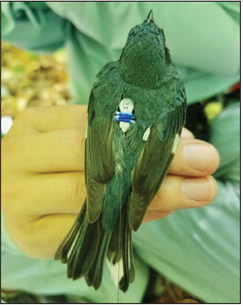Migratory birds take cues from nature to know when they should head south for the winter. Typically, these are birds that depend on insects and aquatic life as their primary food sources—food sources are not available during winter. In spring, the birds return to their northerly breeding grounds where food is again plentiful.
It’s thought that diminishing food sources, fewer daylight hours, and lower temperatures provide birds with indicators they need to begin fall migration to warmer climates. It may also be that many species of birds are genetically programmed for this behavior.
Because birds can’t tell us the reasons they migrate or when, wildlife biologists track bird migration in a variety of ways. In addition to live migration maps that use radar imagery to identify vast populations of birds migrating during spring and fall (visible online at Birdcast.info), observers on the ground verify the radar imagery as they report sightings of migrating birds using Ebird. Both of these citizen science applications are important for gathering migration data, but bird banding and nano-tagging are even more important indicators of migration.
On the ground tracking also occurs at seasonal migratory bird banding stations. In Colorado there are at least a dozen banding stations. At these stations, ornithologists operating under federal banding permits, set up mist nets and capture birds to be banded. After applying a permanent aluminum leg band with a nine-digit number, birds are released; but, not before a thorough evaluation is completed. This includes wing and tail feather measurements, weight, sex and species identification, and aging. All of this data is logged online on the US Geological Society’s North American Bird Banding Program’s website, where anyone can report a found bird with a leg band to determine where and when it was banded.
Some stations are now fitting migratory birds with tiny Motus radio-transmitter tags attached to a lightweight elastic harness. The harness fits over the feet and across the bird’s back under feathers and carries a geolocator tag about the size of a pinky fingernail. Like an aluminum leg band, the tags are numbered and recorded for specific birds. When a bird is caught in a mist net, the banding team will log the recapture and look up when and where it was originally banded, thereby gathering basic information about migration.
Motus tags, while expensive and not yet widely used, transmit better data to researchers looking at migration routes, stopovers, and final destinations. All of which provide important data sets to help conservation of migratory species and their necessary habitats.

Birds, bats and even insects have been fitted with Motus tags and can be monitored if they fly within a few kilometers of a Motus receiver tower. The Motus system puts information gathering on the fast track. Instead of relying on a bird to actually land in a net multiple times, in one country or another, tagging and tracking birds with nanotags allows real-time monitoring of species.
About Migratory Bird Banding Stations
Depending on the stopover location, the weather, and the quality of habitat, birds can stay for a few days or a week or two—enough to get them ready for their next travel day. Locations rich in habitat and food sources provide the best locations for banding stations.
Ridgway State Park, which has hosted an annual fall bird banding station since 2006, sees a lot of Wilson’s Warblers (and other warblers) during its banding season. The station is open Sept. 4-15. There’s a day for the public to come watch – this Saturday, Sept. 9 from 8-11 a.m.
From there, the federally-permitted bander heads to Grand Junction for one month of banding at the Grand Valley Audubon Nature Preserve at Connected Lakes, from Sept. 18 to Oct. 13. Stop in to see these tiny little birds up close and personal at a banding station.
Wilson’s Warblers leave breeding grounds in the Yukon and travel to wintering areas in Central America. On each stopover during its more than 4,000-mile journey, a bird will gain up to 9% of its body weight to fuel the next leg of its flight. Banding stations on the Western Slope aren’t currently nano-tagging migratory birds, but are expected to in the future. Stations in Montana and Canada are using them in limited capacity.
Mary Menz is a naturalist, Colorado Native Plant Master, and author of two books on wildflowers. The most recent is Wildflowers of Colorado’s Western Slope, available at area book sellers. Contact her via email at mary.t.menz@gmail.com.

